Main Article Content
Challenges of Providing Surgical Care in Eastern Zambia
Abstract
Background
Surgery is an integral part of the universal health coverage as there can never be universal health coverage without surgical care. There is little known about what type of surgical procedures are done in the district hospitals and which carder operates on what type of cases. Zambia formulated the national surgical, obstetrics, and anaesthesia Plans (NSOAPs) in 2017 which is a strategic plan aimed at improving surgical services in order to achieve Universal Health Coverage (UHC).
Methods
We conducted an analytical study on the surgical services available in the six major districts, across the province as we conducted surgical camps. We booked patients before the scheduled surgical camps through radio announcements and other established channels. We analyzed the local booking lists and theatre records, assessed the surgical services, accessibility and interviewed the local teams on the challenges being faced.
Results
There were no booking lists in all facilities. 68% of cases done in the district hospitals are caesarian sections with very few other surgical cases. We conducted 219 cases, 63% elective cases and 37% emergency cases of which 53% were obstetric cases. The majority of elective cases were excisions at 40% and hernias were 35%. The lack of human resource was the number one reason why basic surgical procedures were not being done followed by lack of supply of medical and surgical supplies.
Conclusion
There is very little surgery that happens in the district hospitals, apart from caesarian sections which exhaust the operating teams in the facilities. The lack of staff, medical equipment, and poor medical - surgical supplies are the top challenges advanced. There is a lot of work to be done as we thrive to achieve UHC in the Eastern region of Zambia.







